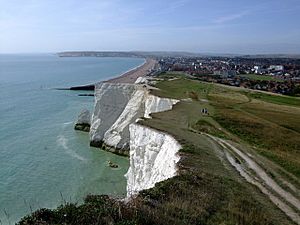Seaford Head facts for kids
Quick facts for kids Seaford Head |
|
|---|---|
 |
|
| Type | Local Nature Reserve |
| Location | Seaford, East Sussex |
| OS grid | TV 509 981 |
| Area | 150.2 hectares (371 acres) |
| Managed by | Sussex Wildlife Trust, East Sussex County Council, National Trust |
Seaford Head is a special natural area located east of Seaford in East Sussex, England. It covers about 150 hectares (that's like 370 football fields!). This beautiful place is officially known as a Local Nature Reserve.
Contents
Discovering Seaford Head
Seaford Head is a very important natural spot. It is part of a larger area called Seaford to Beachy Head Site of Special Scientific Interest. This means the area has rare plants, animals, or geological features that need protection.
What Makes Seaford Head Special?
Seaford Head has many different types of natural environments. You can find chalk grassland, tall chalk cliffs, and areas with bushes and small trees. There are also beaches with shingle (small stones), wet grassy areas, and saltmarshes. When the tide is out, you can explore rockpools filled with sea creatures.
Who Looks After Seaford Head?
Looking after such a big and important place takes a team! Part of Seaford Head, about 83 hectares, belongs to Seaford Town Council. This section is managed by the Sussex Wildlife Trust, a group dedicated to protecting wildlife.
The rest of Seaford Head is split between two other important organizations. Some of it is part of Seven Sisters Country Park. This park is owned and managed by East Sussex County Council, which is a local government body. Another part is owned by the National Trust, a charity that protects historic places and natural beauty spots.
Plants and Animals You Might See
Seaford Head is home to many interesting plants and animals. The chalk grassland areas are especially rich in unique flowers.
Amazing Plants
When you visit, look for these beautiful plants:
- Kidney vetch: A yellow flower that looks like a small cluster of woolly balls.
- Squinancywort: A small plant with tiny pinkish-white flowers.
- Moon carrot: A rare plant with delicate white flowers, similar to wild carrot.
- Clustered bellflower: A purple bell-shaped flower that grows in groups.
Wonderful Butterflies
Seaford Head is a great place for butterflies! The special plants here provide food and homes for many types. Keep an eye out for these colorful insects:
- Silver-spotted skipper: A fast-flying butterfly with orange and brown wings that have silver spots underneath.
- Chalkhill blue: The male of this species is a stunning sky-blue color.
- Adonis blue: Similar to the chalkhill blue, but with an even more vibrant, deep blue color on the males.
These butterflies are important for the ecosystem. They help pollinate the plants as they fly from flower to flower.

